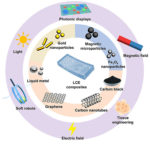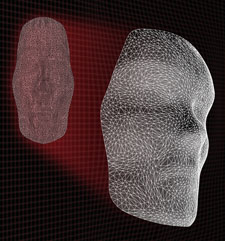Anisotropic nanomaterials such as liquid crystals, liquid crystal elastomer (LCE) and their composites with functional nanoparticles (e.g. metallic nanorods, carbon-based nanosheets, cellulose nanocrystals) combine intrinsic anisotropy and unique functionality, rendering them highly efficient actuators in response to external stimuli, such as light, water, heat, electric and magnetic fields. We investigate the actuation mechanisms, instigate programming and reprogramming strategies, and explore their potential applications such as muscle-like actuators, soft robotics, sensors, and wearables.
Publications
 Wang, Yuchen; Liu, Jiaqi; Yang, Shu*, “Multi-functional liquid crystal elastomer composites”, Appl. Phys. Rev. 2022, 9, 011301 (Invited review). DOI
Wang, Yuchen; Liu, Jiaqi; Yang, Shu*, “Multi-functional liquid crystal elastomer composites”, Appl. Phys. Rev. 2022, 9, 011301 (Invited review). DOI
 Kim, Se-Um; Lee, Young-Joo; Liu, Jiaqi; Kim, Dae Seok; Wang, Haihuan and Yang, Shu*, “Broadband and Pixelated Camouflage by Exploiting Large Poisson Effect in Main-Chain Chiral Nematic Liquid Crystalline Elastomers”, Nat. Mater. 2022, 21(1), 41-46. DOI. SharedIt view.
Kim, Se-Um; Lee, Young-Joo; Liu, Jiaqi; Kim, Dae Seok; Wang, Haihuan and Yang, Shu*, “Broadband and Pixelated Camouflage by Exploiting Large Poisson Effect in Main-Chain Chiral Nematic Liquid Crystalline Elastomers”, Nat. Mater. 2022, 21(1), 41-46. DOI. SharedIt view.
 Aharoni, Hillel; Xia, Yu; Zhang, Xinyue; Kamien, Randall D.; Yang, Shu*, "Making Faces: Universal Inverse Design of Surfaces with Thin Nematic Elastomer Sheets", Proc. Nat. Acad. Sci., 2018, 115 (28) 7206-7211. DOI. arXiv preprint See News
Aharoni, Hillel; Xia, Yu; Zhang, Xinyue; Kamien, Randall D.; Yang, Shu*, "Making Faces: Universal Inverse Design of Surfaces with Thin Nematic Elastomer Sheets", Proc. Nat. Acad. Sci., 2018, 115 (28) 7206-7211. DOI. arXiv preprint See News